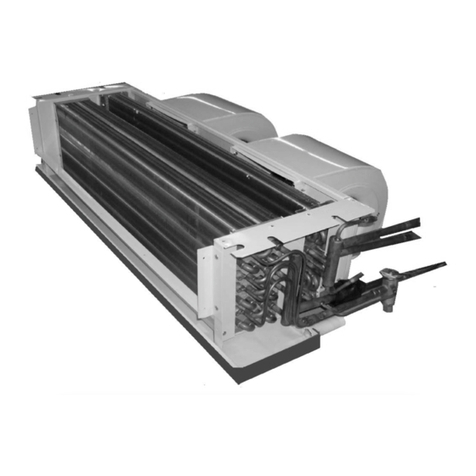
F. Pump:
1. Circulating pump shall be stainless steel with high efficiency enclosed motor.
2. Unit shall have chilled liquid solution piping to the exterior of the cabinet.
3. Shall have a max working pressure of 60 psig.
G. Evaporator:
1. Evaporator shall have one independent refrigeration circuit and one liquid solution circuit.
2. Rated for a refrigerant side working pressure of 450 psig and shall be tested for a maximum fluid-side
pressure of 150 psig.
2. Single pass, ANSI type 316 stainless steel, brazed plate construction.
4. Insulated with closed cell, elastometric foam (ASTM 518)
H. Condenser:
1. Shall be air cooled with integral sub-cooler.
2. One independent refrigeration circuit.
3. Constructed of rifled copper tubing mechanically bonded to aluminum fins.
3. Tubes shall be cleaned, dehydrated and sealed.
4. Assembled condenser coils shall be leak tested and pressure tested at 450 psig.
I. Refrigeration Components:
1. Refrigeration circuit components shall include sight glass, reversing valve, thermal expansion device,
and complete operating charge of both refrigerant (R-407c) and compressor POE oil.
PART 3-Controls and Safties
3.01 Controls
A. Controls:
Unit control shall include the following minimum components.
1. Control transformer to serve all controllers, relays and control components.
2. Pump bypass timer
3. Compressor recycle timer.
4. Optional low pressure bypass timer for low ambient operation.
5. Optional fan cycling control for low ambient operation.
6. Flow switch.
7. Defrost printed circuit board and thermostat.
8. Leaving water temperature thermostat with thermistors installed to measure cooler leaving water flow.
9. Manual heat/cool changeover switch.
B. Unit controls shall include the following functions.
1. Capacity control based on leaving chilled fluid temperature. Temperature setpoint accuracy of +/- 1.0F.
2. Chilled water pump start/stop control.
3.02 Safeties:
A. Unit shall be equipped with thermistors and all necessary components in conjunction with the control system
to provide the unit with the following protectants:
1. Low refrigerant pressure.
2. High refrigerant pressure.
3. Low liquid solution flow.
4 Thermal overload.
5. Short cycling.
PART 4 Operating Characteristics:
4.01 Temperatures
A. Unit shall be capable of starting and running in cooling mode at outdoor ambient temperatures from 55°F to
120°F.
B. Optional Low Ambient Kit shall allow starting and running at outdoor temperatures to – 20°F. A field supplied
and installed crankcase heater must be used when operating at these temperatures.
C. Unit shall be capable of starting and running in heating mode at outdoor ambient temperatures from 70°F
to 17°F.
D. Unit shall be capable of starting up in cooling with a maximum 80°F and a sustained 70°F entering liquid solution
temperature to the evaporator.
E. Unit shall be capable of starting up in heating with a minimum 55°F liquid solution temperature.
F. Minimum 10% Propylene Glycol solution is required. For outdoor temperatures below 32°, reference MAC
Glycol Solution Data Table.
3




























